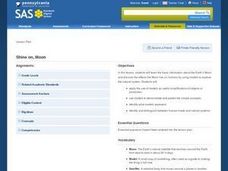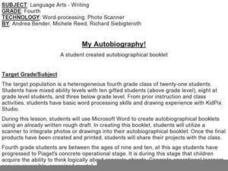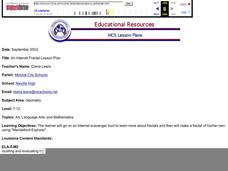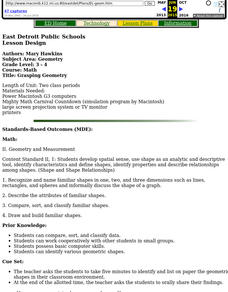Pennsylvania Department of Education
Animal Classes and Their Ecosystems
Students explore animal characteristics by participating in an environment identification activity. In this animal habitat lesson, students discuss a range of different wild life and the ecosystems that they are a part of. Students view...
Curated OER
Weather, Climate and Atmospheric Process
Students explore Earth science by completing a could identification activity. In this weather lesson, students discuss the different forms of measurement for the weather of Earth. Students discuss global warming and examine a list of...
Curated OER
Plants
Students identify and label parts of a plant. They will construct a plant from art material and describe the purpose of each part for the plants survival. Students author a book with pictures and words or a story about a plant.
Curated OER
Spiders Are Fun
Pupils study facts about spiders using a number of literary forms, including stories, poems, and songs. They work with consonant sounds by matching pictures with the beginning consonant sounds. They design art projects that emphasize...
Curated OER
Analogies In Action
Students practice skills to determine the relationship of words. In groups of two, classmates complete a chart to match vocabulary words into specific groups such as synonyms, antonyms, or familial relationship. To reinforce word...
Curated OER
Classification of Animals
Students explore animal characteristics by participating in a SMART board activity. In this animal classification lesson, students utilize a sorting chart to divide different animal names by their observable characteristics. Students...
Curated OER
Surface Area with Polydrons
Students explore measurements by analyzing geometric shapes. In this surface area instructional activity, students identify the terms volume, weight, perimeter and area in order to find the requested measurements of specific polygons....
Curated OER
Reading Comprehension: Is Pluto a Planet?
In this reading comprehension worksheet, students read a passage about Pluto, then complete a set of 5 multiple choice questions. An answer key is included as well as a reference web site for additional activities.
Curated OER
Shine On, Moon
Students explore space science by conducting an experiment in class. In this Moon lesson, students define a list of space science vocabulary and read the book The Moon. Students utilize shoeboxes and string to conduct a sunlight...
Curated OER
My Autobiography!
Fourth graders create autobiographical bookets using an already written rough draft. Using illustrations, scanned photos, and word processing software, they type and print their booklet to share with their class.
Curated OER
Weather Tools
Middle schoolers explore Earth science by participating in a weather identification activity. In this scientific instrument instructional activity, students identify several weather related tools such as the weather vane, thermometer and...
Curated OER
Ozone Pollution: Smog Alert
Students explain ozone pollution and make them aware of how it is formed. They simulate the development of smog and infer how it occurs in nature.
Curated OER
ESOL Shape identification
Pupils review vocabulary shape cards. They match oral words of shapes with flash cards then they make and label their own set of shape flash cards and then review with a classmate.
Curated OER
Geometry: Fractal Scavenger Hunt
Students experience an Internet fractal scavenger hunt. They write a report on fractals using the Internet and recording the sites where they are located.
Curated OER
Sadorus Photograph Collection Activity: Analysis of an Historical Photograph
Young scholars retrive social, cultural, and historical information from a photograph by analyzing the contents. Data about the subject's culture, people, events, and place is explored.
Curated OER
How To Think Like An Archaeologist
Students take a field trip to historical Jamestown. Using artifacts given to them, they must identify them and discover who would have used them and for what purpose. They create a database to organize the information and share it with...
Curated OER
Let's Clean the Beach!
Learners volunteer their time to clean a local park. They estimate the amount of debris they collect and make observations. They write a poem and draw an illustration about their experience.
Curated OER
Grasping Geometry
Learners investigate geometric shapes in their environment, make a geometric design, and write paragraphs describing the design.
Curated OER
Are You a Peacemaker or a Man-Eating Shark?
Second graders work on the concept of fairness, then produce a page on the computer for a class book. They explain the difference between negative and positive behaviors in conflict situations.
Curated OER
Forests, Deserts, & Grasslands
Third graders complete activities to become familiar with the content and vocabulary related to biomes and ecosystems in order to mainstream into the classroom.
Curated OER
"For The Birds" [part II]
Students examine how Chinese and Japanese artists used different kinds of birds
as representations of ideas that were important in both cultures and create their own birds using the technique of origami.
Curated OER
Five Senses-Introduction
Students explore the parts of the body that are used to develop the five senses. They conduct a nature walk. Students identify the things they see, hear, smell, and touch. They create a graphic organizer to organize their answers.






















!["For The Birds" [part II] Lesson Plan "For The Birds" [part II] Lesson Plan](http://content.lessonplanet.com/resources/thumbnails/122476/large/cgrmlwnvbnzlcnqymdeymtaxny0yoda5lwu0ew85zi5qcgc.jpg?1414222640)
